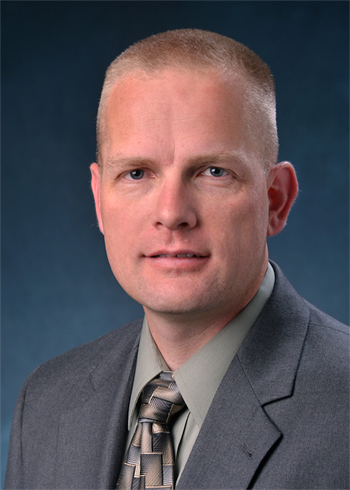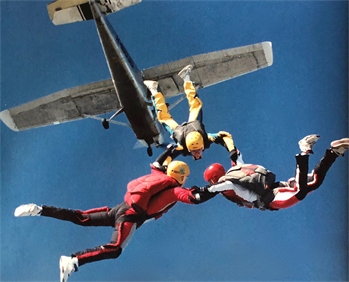AIAA Member Spotlight – April 2018 Written 11 April 2018
AIAA Profiles AIAA Associate Fellow Dr. Hanspeter Schaub
By Lawrence Garrett, AIAA Web Editor

For April 2018, the Institute turns its spotlight toward the Rocky Mountains, home of the Glenn L. Murphy Endowed Chair of Aerospace Engineering Sciences (AES) at the University of Colorado, and Editor-in-Chief of the AIAA Journal of Spacecraft and Rockets (JSR), Dr. Hanspeter Schaub.
Schaub’s lifelong interest in aerospace began at a young age, shaped largely from seeing Star Wars and other Sci-fi films, which created within him “a fascination with space travel.” But growing up in Switzerland, Schaub noted, afforded him little-to-no opportunity to pursue an education in aerospace engineering. Fortunately, he earned the chance to spend a year in the United States as a high school exchange student and that allowed him to learn about the many opportunities to pursue aerospace engineering degrees. Following high school, Schaub came to Texas A&M University to study aerospace engineering, a curriculum that combined his “passion for space travel, physics and math.”
Schaub earned his B.S. in Aerospace Engineering in May 1992, graduating Magna Cum Laude. He continued at Texas A&M, earning his M.S. in Aerospace Engineering in August 1994, and his Ph.D. in Aerospace Engineering in May 1998.
An AIAA Associate Fellow, Schaub is an extremely dedicated educator, researcher, and mentor. In addition to his endowed chair position and service as editor-in-chief of JSR, he’s also the university’s director for the Autonomous Vehicle Systems (AVS) Laboratory, the AES associate chair of graduate affairs, the Laboratory for Atmospherics and Space Physics (LASP) senior associate for engineering research and education, and associate editor of IEEE Transactions on Aerospace and Electronic Systems.
While an undergraduate student at Texas A&M, Schaub heard about AIAA through several of his professors. Knowing early on that he’d be spending his career in the aerospace engineering field, he decided that AIAA was a society he needed to be a part of, and joined in December 1989 as a sophomore student.

Schaub has been active in the Institute ever since, attending many AIAA conferences and forums over the years, where he’s presented many of his papers. These opportunities have had a positive impact on his career, Schaub said, noting that it’s only at AIAA conferences and forums where he’s able “to meet and engage with the best researchers” in his field.
Schaub has also served as the associate editor for the AIAA Journal of Guidance, Control, and Dynamics , from 2007 to 2013, and is currently a member of the AIAA Publications Committee, which he joined, he said, “to support the field of aerospace engineering.” He noted that serving as an associate editor helped him “stay on top of the field and give back to the community.” Schaub is currently an advisory board member of AIAA’s Education Series books, which in addition to his role as editor-in-chief of JSR, allows him “to oversee publications across a fascinatingly broad set of spacecraft and rockets-related research topics.”
Schaub maintains that the primary benefit of AIAA publications, “especially the books,” is that they exist to serve the entire aerospace community. “AIAA understands the aerospace field very well, and is ready to handle book volumes that are not as large as [in] larger fields like mechanical engineering. This allows authors to create aerospace-related specialty books, and keep them available to the community long after the initial publication,” he explained.
Schaub said he was drawn to teaching by his passion for and enjoyment of the “research side of aerospace engineering.” But as a graduate student, before becoming a professor, Schaub was already teaching, having earned jumpmaster and instructor teaching ratings as a skydiver. Whatever the venue, he’s “always enjoyed teaching.”
Schaub noted that the best part about being a professor are the many opportunities to “advise and foster new graduate researchers.” As the department’s associate chair of graduate studies, Schaub said he is continually amazed by his students’ talents, enjoys engaging with the “entire graduate student population,” and is proud to take part in the professional development of many of them.
One of the highlights of his career as a professor, Schaub recalled, was being nominated and selected for the university’s Faculty Advisor Award. What made it so noteworthy for him was the fact that a number of his graduate students banded together and nominated him for the award, unbeknownst to Schaub at the time. Schaub explained, “I have received several professional honors in my career from AIAA and other institutions. However, getting this advising award from the graduate students meant a lot to me as I engage very strongly with them.”
Schaub has been the recipient of numerous professional awards throughout his career, including the H. Joseph Smead Fellowship, the Provosts Faculty Achievement Award, the Faculty Assembly Award for excellence in teaching, as well as the Outstanding Faculty Advisor Award. He is also the recipient of a number of AIAA awards. A member of the AIAA Associate Fellow Class of 2007, he most recently received the 2017 J. Leland Atwood Award, honoring his commitment to excellence in Aerospace Engineering Education, as well as the 2018 Mechanics and Control of Flight Award.
Schaub said he works hard to “balance both the research and educational aspects of being a professor,” and being the recipient of both AIAA awards, “one for education and one for research … was a huge honor.” He added that “it was a pleasure to meet the other award recipients” and “humbling to learn about their many aerospace-related achievements.”
Schaub’s research, which includes 20+ years of experience, including four years at the prestigious Sandia National Laboratories, focuses on nonlinear dynamics and control, astrodynamics, relative motion dynamics, and relative motion sensing. Author of approximately 137 journal articles and 208 conference publications, Schaub enjoys publishing on a broad set of astrodynamics-related topics. “I always enjoy [writing] the papers on charged astrodynamics as this field is very young, and there are novel and unintuitive results to be explored,” he explained, adding that authoring the papers allows him to expand his technical expertise into new areas.

Schaub is also coauthor, with John L. Junkins, of Analytical Mechanics of Space Systems, Fourth Edition , a recently released AIAA book featured in the March Momentum. The 2nd edition of this book earned Schaub and Junkins the AIAA Summerfield Book Award in January 2013. Schaub described the 4th edition as having “the largest amount of new technical content compared to the other editions,” which “refines some of the developments in chapter 14 on formation flying, and includes recent results on doing power optimal control.” The most noteworthy addition in the 4th edition, though, noted Schaub, “is the expanded dynamical development where the angular momentum is not just taken about the center of mass, but about any arbitrary body-fixed location.”
Schaub explained that his research laboratory is in the midst of supporting the “attitude dynamics and estimation algorithm development and simulation for a Mars mission,” and that their development was helpful toward those efforts and led to some fascinating new formulations for complex spacecraft designs, some of which are now included in the 4th edition.
Offering advice to today’s students and aspiring aerospace engineers, Schaub recommended they become members of AIAA because the Institute “supports students and young professionals at the conferences, and offers up a range of scholarships.” He also said that “this is a very exciting time to be in the space industry,” because it is “entering a new phase with the emergence of commercial space operations,” and that “a time is near where there is an economic driver for space travel that is not directly tied to government spending.”
Schaub pointed to the ongoing efforts to land large robots on Mars, and the commercial space industry’s development of reusable rockets, which will “significantly drive down the cost to access space.” He also noted that a significant benefit of being in the aerospace engineering field today is that it is “full of exciting research in a broad and diverse set of topics,” and that aerospace programs are “undergoing aggressive growth” with no end in sight.
Looking to the future, Schaub believes cheaper access to space will be “transformative,” and will “allow us to advance space technology at a pace unseen in the past.” He said he’s also “fascinated with the massive satellite constellations being proposed,” and that to make them a reality, “new paradigms for mission development and control” will be needed. He pointed to the small satellite market as a facilitator, a market that allows the satellite engineer to develop and test “very advanced autonomous control systems.” With the ability to field and test new space-related autonomy, Schaub thinks “we’ll see breakthroughs in the spacecraft robustness and independence, allowing new types of lower cost missions to be considered.”
In his free time, which, understandably, Schaub said he doesn’t have much of, he enjoys adventure traveling, hiking in nature, and “cooking a great meal for a house full of friends.” He also enjoys spending time with his dogs, noting that his “work pace would not be possible without coming home to these fuzzy friends.”
The Institute salutes Dr. Hanspeter Schaub, thanks him for his many outstanding contributions to the Institute, including his expert oversight of the Journal of Spacecraft and Rockets, and wishes him all the best as he continues to pursue revolutionary research, and the vital mentoring of the next generation of aerospace engineers.
